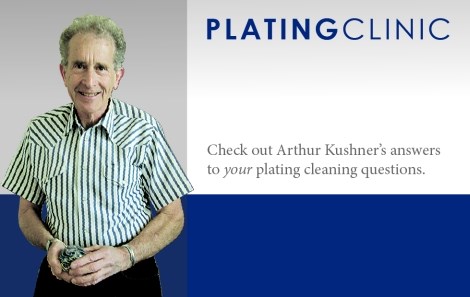Ask Art Kushner: Zinc-Plated Pipe Fittings
Q: We zinc plate then apply a yellow trivalent chrome conversion coat to pipe fittings. The rack-plated, large-size pipe fittings look great after plating, but a few days later start to show spots of corrosion. Any suggestions?

Q. We zinc plate then apply a yellow trivalent chrome conversion coat to pipe fittings. All of our barrel-plated parts are great. The problem is rack-plated, large-size (more than 4-inch) pipe fittings. They look great after plating, but a few days later start to show spots of corrosion. I believe this is due to the porosity of the base metal, but it only occurs on large pieces. Our plating cycle is as follows:
1. Hot soak for 5 min.
2. Rinse
3. 15-percent hydrochloric acid for 10 min.
4. Rinse three times
5. Zinc chloride plate for 20 min.
6. Trivalent chromium conversion coating for 30 sec.
7. Rinse twice
8. Blow dry.
We do not electroclean the parts. Do you have any suggestions for solving this problem? —W.J.
A. Thank you for supplying reasonable details on your plating process. Assuming the process steps for both are the same, I would investigate whether the same base material is used to manufacture both the small fittings and the large fittings. I would also investigate your cleaning steps for the large fittings. The base materials may be undercleaned and, surprisingly, you may have overclean parts. Overcleaning can open pores that, in turn, can give rise to the delayed corrosion that you see. Try cleaning the large pieces for a shorter period of time. If this seems to reduce the amount of delayed corrosion that you see, you are on the right track.
Another step that you should investigate is applying a somewhat thicker layer of zinc to the parts. It might be helpful to determine the thickness of the zinc on the barrel-plated parts versus that on the rack-plated parts.
Related Content
-
Finishing Systems Provider Celebrates 150 Years, Looks to Future
From humble beginnings as an Indiana-based tin shop, Koch Finishing Systems has evolved into one of the most trusted finishing equipment providers in the industry.
-
Corrosion Protection Options for Aluminum
Seeking to understand aluminum corrosion and prevention? Jacob Weingart of Columbia Chemical offers a helpful overview of corrosion protection options for aluminum and its alloys.
-
10 Anodizing Best Practices
Following this list of guidelines can help to increase the performance, cost effectiveness and quality for your anodizing operation.












